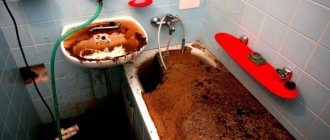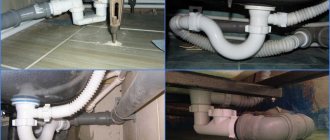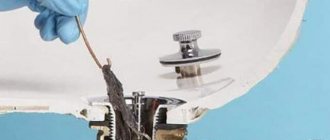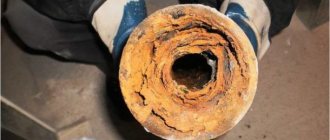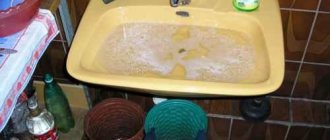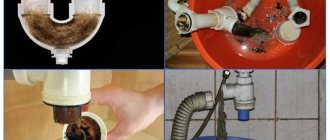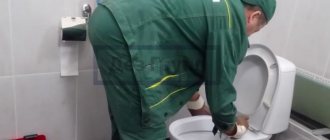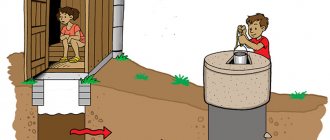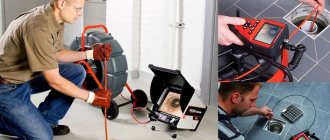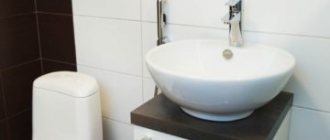In most cases, you can correct the situation on your own, using mechanical cleaning methods, special chemicals and even folk recipes.
In this article you will learn how to quickly and effectively clear a clogged kitchen sink at home.
Reasons for appearance
Before cleaning the drain, it is recommended to determine the cause of the blockage. The main ones include the following:
- Incorrect installation of plumbing. This could be, for example, installing waste pipes at the wrong angle.
- Foreign objects entering the drain that block and clog the pipe.
- Gradual accumulation of fat and other deposits in the pipes.
In cases where improper installation occurs, simply cleaning the pipes is not enough.
How to clean mechanically?
Mechanical cleaning methods are often used to remove blockages . These include the use of a glass, a plunger or a special cable.
Plumbing cable
The cleaning cable is often metal. It has a handle on one side and a split, hard end for cleaning on the other.
Application:
- The working part is lowered into the drain.
- By turning the handle, the cable is moved along the drain pipe.
- After removing the cable from the drain, there may be debris at the end of the cable that is obstructing the passage of water.
- Repeat the procedure several times.
- Check the quality of cleaning by pouring water into the sink.
- If necessary, I repeat the processing.
Mechanical cleaning can be supplemented by using special chemicals or home recipes.
You can watch how to work with the cable in the following video:
Cup
For small blockages, when water passes through, but not as quickly as usual, even an ordinary glass can help.
Principle of operation:
- take some water into the sink;
- lower the glass so that it covers the drain hole;
- press and then sharply move your hand with the glass up;
- repeat several times.
Cleaning using this method is similar to the principle of using a plunger, but it will not help deal with serious blockages.
plunger
It is advisable to have a plunger in the household - a simple tool that will help deal with fresh blockages.
Procedure:
- fill the sink with some water;
- install the plunger so that the drain is completely covered with the working nozzle;
- press the plunger with force and pull it sharply towards you;
- repeat the treatment several times in a row, even if the plug has already been removed.
In addition to the usual plunger, you can use pneumatic models.
Hydraulic pump to remove blockage
If it is impossible to clear a clogged sewer pipe with a plunger, you can use a simple manual hydraulic pump. A powerful water flow to erode the plug through the pipe is directed downwards. If the plug is strong enough, then in order to move the plug up the pipe, it will be possible to use an upward movement, creating a suction force that may be quite sufficient for this.
The process technology is quite simple:
- The overflow hole should be covered with a damp cloth.
- Then fill the pump with water from the tap.
- Press the pump nozzle quite tightly against the drain hole.
- It is necessary to pump until the pipe is freed from the plug.
A conventional manual hydraulic pump can be used for cleaning.
How to remove using folk remedies?
Even simple homemade recipes can help solve the clog problem. But it is better to use them in cases where the blockage is not severe. If the water does not drain from the sink at all, it must be scooped out before cleaning.
Boiling water
This is the simplest and most accessible.
Procedure:
- It is necessary to bring at least 1.5 liters of water to a boil.
- Pour boiling water into the sink, being careful to direct the stream into the drain.
- If the water begins to go away, then after 1.5 hours the procedure must be repeated. Otherwise, you will have to try another drain cleaning option.
This method is suitable for flushing out the blockage only if the pipes are not made of plastic. Otherwise, only water with a temperature of up to 70 degrees can be poured into the sewer. Failure to comply with this requirement may result in damage to the plastic pipeline.
Vinegar and soda against fat deposits
To clear clogs caused by food debris, especially greasy food, the baking soda and vinegar method can be used.
Procedure:
remove all water from the sink;- pour ½ pack of soda into the drain hole;
- pour in ½ cup vinegar;
- plug the drain hole to ensure that the chemical reaction takes place in the pipes and not on the surface of the sink;
- wait until the chemical reaction with the formation of foam is completed;
- pour 1.5 liters of boiling water (hot water) into the sink drain hole;
- Run cold water for 3 minutes to flush out the drain.
You can use cleaning with soda and vinegar as a preventive measure.
Hangover pills
If the blockage is not severe and you don’t have soda on hand, you can use effervescent hangover tablets. Alka-Seltzer will do.
Application is simple:
- In a saucepan, mix 2-3 tablets of the drug with a glass of vinegar.
- Quickly pour the foaming solution into the drain.
- Immediately plug the hole with a rag.
- After 10 minutes, turn on the water under pressure.
Alternative use of tablets:
- Grind and pour 2 tablets into the drain.
- Pour in a glass of vinegar.
- Plug the drain hole in the sink.
- Wait a few minutes for the reaction to pass.
- Run hot water.
Salt and soda
Kitchen drain pipes are susceptible to deposits from grease that gets into the pipes when washing dishes.
Application procedure:
- combine 4 tablespoons of salt with 2 tablespoons of soda in a container;
- pour two glasses of water;
- pour into the drain;
- plug the kitchen sink drain;
- stand for 10 minutes;
- run hot water.
This method cannot deal with old blockages.
Why do summer residents pour salt into the toilet?
It is also customary for summer residents to pour the product into the toilet, but for a completely different purpose. If the room is not heated in winter, the water in the water seals freezes and turns into ice. Breaks occur. To avoid this, the water is sucked out and the sewer outlets are sealed.
We recommend: Getting rid of mosquitoes with Raptor products
Using salt is an alternative method. A strong saline solution does not freeze even at a temperature of -20 degrees. Therefore, on the last pre-winter visit to the dacha, one or two packs of NaCl (1–2 kg) are poured into the toilet.
How to quickly remove with special chemicals?
Various preparations can be used to clean kitchen drains. They are available in liquid form, in the form of granules in sachet.
The main point when choosing is to make sure that the product is suitable for the existing type of pipes and the expected type of contamination.
Bagi Schumanit
The drug, produced in Israel, is available in granular form . It allows you to completely eliminate the blockage in just 3 minutes, dissolving food residues and fat accumulations. Suitable for all types of pipes. Contains sodium hydroxide.
For the product to work, you need to remove the water from the sink. The contents of the sachet are poured into the drain and ½ cup of hot water is poured in. After 3 minutes, the sink is washed with a large stream of water.
Advantages:
- destruction of bacteria;
- elimination of odors;
- very high efficiency;
- fast action;
- dissolution of organic and inorganic substances.
Minuses:
- high price;
- caustic composition.
The average cost of a package is 150 rubles. The product is also available in gel form. Read reviews here, here and here.
Gel Mr.Muscle
The drug in gel form is an effective remedy that acts in a few minutes. If the plug situation is stubborn, the product may need more time to clear the drain.
Advantages:
- efficiency;
- ease of use;
- elimination of bacteria.
Minuses:
- caustic composition;
- price;
- high consumption of funds;
- for advanced cases it will take several hours.
Price – 300 rubles. You will find reviews here and here.
Tire Turbo
The gel is intended for cleaning pipes at home. The product is suitable for all types of pipes. Contains chlorine. A single treatment of one drain hole requires 250 ml of product.
Advantages:
- efficiency;
- works even when there is water in the sink;
- eliminates bacteria.
Minuses:
- price;
- high consumption.
Cost – up to 400 rubles. Reviews can be found here, here and here.
Cleaning the sink using mechanical methods
Not everyone understands what to do if the kitchen sink is clogged. There are more than 20 different methods for resolving the issue. To remove blockages, mechanical devices are used to clear the pipeline.
plunger
A plunger is a tool for cleaning a sink drain, consisting of a plastic or wooden handle and a rubber corrugated cap. Its operating principle is similar to that of a back pressure pump. When performing upward and downward movements, the debris accumulated in the siphon area rises upward.
How to clear a blockage at home:
- to create hydraulic pressure, the overflow holes in the sink are closed with plugs;
- the plunger is pressed against the drain hole;
- fill the sink with water;
- make rhythmic forward movements.
When the handle is lifted, the water moves behind the cap, which rises upward. When you press on the plunger, it moves upward by inertia, so part of it spills out from under the edges of the plunger. As a result, water along with dirt is pumped out of the clogged pipe.
If, after using the plunger, water easily flows into the pipeline, this indicates that the blockage has been removed. To speed up the process, before filling the sink with water, pour 100-150 ml of liquid soap into the drain. This way you will not only remove the blockage, but also remove plaque from the walls of the sewer.
Plumbing cable
Drain cable (cobra) is a device for removing sewer contaminants, which consists of a wire coiled into a spring and a handle. Mechanical cobras are used to clear sewers, but in case of serious blockages in general sewer systems, motorized devices are used.
The principle of operation of the plumbing cobra is very simple. Like a corkscrew, it is screwed into a clogged pipe, which leads to the destruction of compacted contaminants.
How to clean if your kitchen sink is clogged:
- the sink is filled with water;
- one end of the cobra is placed in the drain channel;
- by turning the handle at the second end, the cable is pushed forward;
- the wire along with the contaminants is pulled out of the sewer.
To clear the clogged pipe of contaminants, open the hot water tap for 2-4 minutes.
Wire hook
If the sink in the bathroom or kitchen is clogged, and special gels or solutions do not help, use a wire hook. It is a cobra-like device with a hook at one end. When the wire rotates, contaminants are wound around it, preventing the outflow of water.
Before clearing the clog in the kitchen sink, determine the appropriate nozzle. Depending on the composition and diameter of the plug, the following are used to remove it:
- peaks – remove accumulated fat;
- scraper - cleans the walls of the sewer from plaque;
- augers – grind non-solid deposits;
- hook - pries up and removes garbage plugs.
To remove the blockage, the hook is lowered into the drain hole, then turned several times and pulled out.
This method is not intended for cleaning sewer networks made of plastic - polypropylene and PVC. This is associated with a high risk of damage to the internal walls.
Flexible shaft
A flexible shaft is a springy wire braided with plastic or rubber. It differs from the cobra in the ability to transmit torque between axes that constantly change orientation relative to each other. Such a device will help break through blockages in any section of the sewer.
To remove contaminants, different attachments are attached to the shaft:
- spiral;
- harpoon;
- sliding knife;
- hook;
- saw;
- scraper.
The springy wire is enclosed in soft insulation, so it is suitable for cleaning any pipes made of any materials - metal, polyvinyl chloride, polypropylene.
Steel tape
Long steel strips are used to break through clogs in the sink. They are strips of metal with peaks at the end. Thanks to this nozzle, it is possible to remove plugs from the pipeline.
How to break through a sink with steel tape:
- the sink is filled with water;
- a tape is placed in the drain;
- rotate around its axis several times;
- removed along with the dirt plug.
This device is suitable for breaking through blockages in sinks of any complexity. The belt is made of high carbon steel, which ensures a long service life.
Vacuum cleaner with blowing mode
A blowing vacuum cleaner will help you quickly remove dirt from the siphon. The procedure is performed like this:
- the water is scooped out from the sink;
- a rubber cap is attached to the vacuum cleaner air duct;
- press the nozzle to the drain;
- turn on the vacuum cleaner for blowing.
If the plug is successfully removed, you will hear a characteristic pop. But this method is suitable for dealing with minor blockages. If the length of the plug is 5-7 cm, only a cobra, a flexible shaft or a hook can cope with the task.
Disassembling and cleaning the sink siphon
When it is not possible to remove the blockage in the sink with tools or chemicals, you will have to completely disassemble the siphon. Modern drainage elements are made of plastic that can be easily unscrewed, so even a beginner can handle the task.
Disassembling the siphon:
- empty the water from the sink;
- place a basin under the siphon;
- unscrew the connection at the water seal level;
- remove dirt deposits.
If during disassembly fatty deposits are visible on all elements of the siphon, it is completely dismantled and cleaned. After cleaning, the drain elements are screwed back to the sink, not forgetting to install the O-rings.
Disassembling the siphon
Directly under the kitchen sink there is a siphon - a simple structure that can be disassembled. This method is very effective when the cause of the blockage is in the siphon. After all, the water draining from the sink first enters it.
Procedure:
- Free up space under the sink.
- Place a bucket under the siphon.
- You need to unscrew the plastic nuts holding the siphon. Or you can unscrew only the siphon sump nut. In this case, the entire contents of the sump will flow into the bucket.
- Clean and rinse the removed part.
- You can also disconnect the corrugated pipe leading to the drain and wash it as well.
- Install all elements in their original place.
If partial dismantling of the siphon is not possible, it is removed completely, disconnecting it from the sink and drain pipe, and then washed and cleaned in a separate container.
The procedure for cleaning the siphon can be seen in the video:
Preventive measures
Even with careful use of the sink, the following gradually accumulates in siphons and pipe outlets:
The absence of an unpleasant odor and the cleanliness of the pipes can be ensured by treatment with a chemical intended for cleaning sewers, which is carried out regularly. Also, a product intended for clearing blockages should be used as soon as the water begins to flow more slowly, so that later you have to think less about why the kitchen sink is clogged.
In this case, it is necessary to strictly follow the manufacturer's instructions so that handling of the chemical becomes harmless.
If, after cleaning the pipe outlet, the unpleasant odor still remains, then a small amount of antiseptic should be poured into the sink overflow hole.
Source
Features of cleaning plastic pipes
Cleaning plastic pipes requires special care. Despite the strength, the material from which the drainage system is made is susceptible to mechanical damage and exposure to very high temperatures.
The inner surface of the pipes is quite smooth; with proper installation, blockages in such a system occur less frequently than in cast iron drainage systems. This is explained by the fact that plastic is not prone to corrosion and the adhesion of various substances to the surface .
But during operation, food particles that fall into the kitchen drain can be deposited, causing a blockage. The best options for cleaning approaches are the use of a plunger, the use of home and special products.
Call a plumber
In situations where you cannot cope with the blockage on your own, you will have to turn to the help of a plumber.
Also, the intervention of a specialist will be needed when the problem with blockage is related to the drainage system in the apartment or to the riser in the house.
The cost of the service is determined by the complexity of the problem and the necessary cleaning work. If replacement of units or individual parts is required, the customer pays for them separately. On average, in the capital, clearing a clogged sink will cost from 500 rubles.
Prohibitions when cleaning
When starting to clear a clogged kitchen sink, you need to remember a number of prohibitions:
- Do not begin to break the plug while there are dishes in the sink. It and food must be removed in advance.
- You should not get to work without rubber gloves. This is especially important when using purchased chemicals, since such products have an aggressive composition.
- Do not use chemicals that are not intended for this purpose to clean pipes. They can emit toxic fumes and even damage pipes.
- You should not pour all the products that come to hand down the drain at the same time, as this can harm communications.
Chemicals for cleaning sinks
Preparations for clearing blockages are available in the form of liquid, gel, powder or granules.
Chemicals for clearing clogs.
The principle of their use is the same:
- Liquid chemicals are poured into the sink opening and left for several minutes or hours.
- The granules are poured into the drain, a small amount of water is added and left for the time specified by the manufacturer.
- At the final stage, the pipeline is washed with plenty of running water.
Under the influence of alkaline and acidic compounds that are part of household chemicals, all types of organic matter dissolve:
- fatty deposits;
- lime deposits;
- leftover food;
- fruit and vegetable peels;
- hair.
Manufacturers place detailed instructions on the packaging of their products, which indicate the purpose, composition, method of use and safety measures.
Before starting work, you should carefully study this information and remember the following precautions:
- Do not shorten the exposure time of the drug, otherwise it will not have time to completely destroy the blockage.
- Do not use the product to clean plumbing fixtures and pipes for which it is not intended.
- When working with household chemicals, follow safety precautions and wear protective equipment - goggles, gloves, a respirator. If aggressive substances get on the skin, they can cause a burn; if they come into contact with the mucous membranes of the eyes, they can cause irritation and vision problems; if they inhale toxic fumes, they can cause poisoning and accompanying symptoms (nausea, vomiting, dizziness, headache, surges in blood pressure).
To combat blockages, buyers choose chemicals that, in most cases, are able to unclog the sink the first time:
| Release form | Names of household chemicals for removing blockages |
| Liquid | Mole |
| Gel-like | Mister Muscle, Sanox Clean stock, Deboucher active, Tiret turbo, Kloger Turbo |
| Granular | Anti-clogging, Bagi Pothan, Chirton Clean drains, Krotex, Mister Muscle, Mole, Floop |
However, chemicals are powerless against objects of inorganic origin that fall into a drain or sewer pipe.
Liquid cleaning agent Mole for sink blockages. Mister Muscle, a clog-cleaning gel. Kloger Turbo is a gel-based cleaner for blockages. Granular cleaning product Mole. Gel-like cleaner for removing clogs. Bagi Pothan granular sink cleaner. Cleaning granular for blockages Chirton Clean drains. Tiret turbo gel-like cleaning agent for sink blockages. Deboucher active removes clogs from the sink.
Prevention measures
To prevent blockages from recurring, preventive measures should be taken into account:
- Periodically you need to rinse the sink by running boiling water or hot water if the pipes are made of plastic;
- It is necessary to insert a special strainer into the kitchen sink drain, which will prevent large fragments of food waste from getting into the drain;
- You should not shake bread crumbs into the sink, wash off tea leaves, or pour out greasy liquid, as all this will stick to the pipes and accumulate in the siphon.
Tips from the professionals
Tips from plumbers will help you better cope with cleaning your kitchen sink:
If clogged pipes are a frequent and regular occurrence in your home, then it makes sense to purchase a plumbing cable. It is inexpensive and will last for many years. Having a comfortable handle at one end is a must.- If the problem with blockages is related to installation errors, it is recommended to correct them, otherwise blockages will occur constantly.
- If the blockage was broken through with a cable, it must then be cleaned of dirt and dried. Store in a dry place, rolled up.
- It is better to clean drains in the kitchen with the window open so that there is an influx of fresh air, since in most cases the smell will be unpleasant.
- The combination of mechanical and chemical methods makes pipe cleaning more effective. For example, use a plunger, and then use special household chemicals.
If you are interested in how to clear a clog in a pipe, sink or toilet, take a look at this section.
